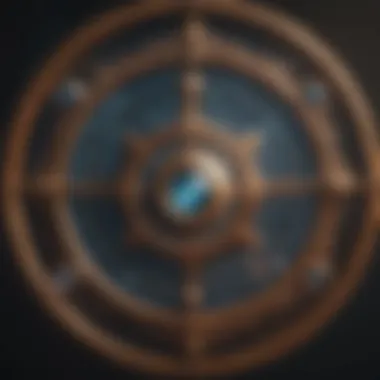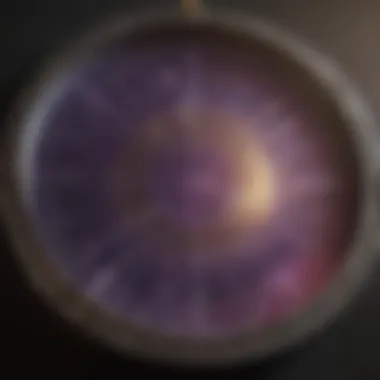Astrology Natal Chart Compatibility Explained


Intro
Astrology has intrigued humanity for centuries, offering a lens through which we examine our lives and relationships. At the heart of this celestial wisdom lies the natal chart, a map of the sky at the moment of an individual's birth. Each natal chart holds a wealth of information, indicating not only personal traits but also the dynamics of compatibility with others. Understanding how these charts interact can illuminate the ways individuals relate to one another.
Astrological compatibility is not merely about sun signs. It incorporates various elements, including planetary placements, aspects, and specific chart components. Each individual brings unique energy through their natal chart, and deciphering this energy can help unveil deeper connections or potential challenges in relationships.
The following sections will delve into essential aspects of astrology natal chart compatibility, shedding light on how celestial influences affect interpersonal connections. Providing insights into zodiac characteristics, birth chart elements, and astrological events will empower readers to enhance their personal growth and relationship dynamics.
Foreword to Astrology and Natal Charts
Astrology provides a lens through which to interpret the cosmic influences on human life. It offers valuable insights into personal characteristics, motivations, and relational dynamics. Understanding astrology is essential for interpreting how individual natal charts interact in the context of relationships, thus facilitating deeper connections with oneself and others.
Defining Astrology
Astrology is the study of celestial bodies' positions and movements and their influence on human affairs. It is built upon the connection between cosmic events and personal experiences. By studying the placement of planets, stars, and other celestial phenomena at the time of an individual’s birth, astrologers can derive insights about personality traits, emotional responses, and even life events. This field encompasses a variety of practices, from horoscopes to the analysis of natal charts. The basic premise is that the universe is interconnected and that the cosmos can provide guidance and understanding of human nature.
Understanding the Natal Chart
A natal chart is a map that captures the positions of celestial bodies at the exact moment of an individual's birth. Each chart is unique and reflects an individual’s potential, strengths, challenges, and tendencies. Analyzing this chart allows for a deeper understanding of one's identity and the underlying forces that shape behavior and experiences. It acts as a blueprint that can help individuals navigate their personal and relational journeys more effectively. In the context of compatibility, the natal chart serves as a foundational tool for exploring interpersonal dynamics.
Components of a Natal Chart
Sun Sign
The Sun Sign is perhaps the most recognized aspect of astrology. It represents core identity, ego, and conscious self-expression. The Sun Sign sets the foundation for personality development and individual expression, making it a focal point in relationship compatibility analyses. Most people identify strongly with their Sun Sign, often seeing it as a reflection of their core self. Its strengths can include self-awareness and confidence, while potential weaknesses may be egocentrism and stubbornness. Understanding someone's Sun Sign can reveal much about their fundamental motivations and behavior in relationships.
Moon Sign
The Moon Sign reflects emotional life and inner self. It governs instincts, habits, and subconscious reactions. A person's emotional landscape can often be traced back to their Moon Sign, as it influences how one processes feelings and relates to intimacy. The Moon Sign is a beneficial aspect to consider, as it offers insights into emotional compatibility and security within relationships. This component can show vulnerabilities and strengths, enriching the compatibility analysis. Its unique feature is its ability to highlight how partners may react differently to emotional situations, impacting relationship dynamics significantly.
Rising Sign
The Rising Sign, or Ascendant, symbolizes the face one presents to the world and influences first impressions. It affects how individuals navigate their environment and embodies the traits they project outwardly. This component adds complexity to compatibility discussions, as it suggests that two people may resonate on different levels. The Rising Sign can inform partners' approaches to life, their responses to social situations, and their outward demeanor. Its characteristics can either complement or contrast with other signs in a natal chart, making the understanding of the Ascendant essential for a holistic overview.
Planets and Houses
The positions of various planets, along with the houses they occupy, are critical elements in a natal chart. Each planet represents different facets of life, from love and communication to challenges and ambitions. The houses indicate the areas of life affected by these planets, creating a nuanced picture of how someone interacts with the world. For instance, Venus in the 7th house might denote a strong focus on partnerships, while Mars in the 10th house may speak to career ambitions. Recognizing the interplay between planets and houses can help identify compatibility factors and relational dynamics, guiding individuals in understanding how external influences shape their interactions.
The Concept of Compatibility in Astrology
Understanding compatibility within astrology is fundamental to exploring relationships on a deeper level. Compatibility does not merely refer to the superficial traits that two people share. Instead, it incorporates the actual interplay of their natal charts. Each natal chart is a unique map of an individual's astrological placements, and when these maps connect, they create a complex web of influences that can either enhance or hinder relationships.
Astrology posits that compatibility is significantly rooted in how the planetary arrangements in two individuals’ charts interact. This interaction can provide profound insights about potential challenges and synergies. By analyzing the elements of compatibility, one can also uncover underlying motivations and emotional resonances, which are vital for achieving understanding and harmony in relationships.
What is Compatibility?
In astrological terms, compatibility refers to how well two individuals can connect based on their astrological placements. This includes sun signs, moon signs, rising signs, and other planetary influences. The essence of compatibility lies in the ability of each partner to complement, challenge, and support one another through their inherently different energies.
Compatibility is often broken down into three main types:
- Elemental Compatibility: This considers the four elements—fire, earth, air, and water. Each element has its unique characteristics that can either facilitate connections or lead to friction.
- Aspectual Compatibility: The angles formed between the planets in the two charts can significantly influence how relationships flow, creating ease or tension.
- Personal Growth Compatibility: This focuses on how partners support each other’s individual development and evolution through the journey of their relationship.
Astrological vs. Psychological Compatibility


Astrological compatibility looks at the celestial factors that influence relationships. It relies on the understanding of how planetary placements affect emotional responses, communication styles, and relational dynamics.
In contrast, psychological compatibility is based on individual conditioning, life experiences, and emotional intelligence. While astrological insights provide a lens through which to view interpersonal dynamics, psychological compatibility emphasizes behavioral patterns shaped by one’s upbringing and personal history.
Both astrological and psychological compatibilities play a vital role in the overall dynamic of a relationship. Understanding each can empower individuals to address friction and embrace harmony more effectively.
Why Compatibility Matters
Compatibility is crucial for numerous reasons:
- Emotional Stability: Recognizing and acknowledging the compatibilities and incompatibilities can lead to a healthier emotional dynamic. A well-matched pair can navigate challenges more adeptly, fostering a sense of security and understanding.
- Conflict Resolution: By understanding astrological influences, partners can better anticipate potential conflicts. This awareness can act as a guiding light during turbulent times.
- Supportive Growth: Compatibility encourages personal growth within relationships. A partner who understands and supports individual aspirations can facilitate a nurturing environment.
In summary, the concept of compatibility in astrology provides valuable frameworks for understanding relationships. Recognizing how individual natal charts interact offers both insights into current dynamics and guidance for future growth in interpersonal connections.
Analyzing Natal Chart Compatibility
Analyzing Natal Chart Compatibility is a crucial aspect of understanding how individual astrological charts influence relational dynamics. Each natal chart charts cosmic positions at the time of one’s birth. These charts reveal much about personality, emotional tendencies, and life challenges. Therefore, comparing two charts provides insights into compatibility, highlighting potential areas for harmony and conflict.
Understanding how the elements of each chart interact can deepen relationships. For example, significant planetary placements such as the Sun, Moon, and Rising signs can provide important clues regarding how two people may bond or struggle together. This step goes beyond surface-level traits found in Sun signs alone, offering a richer analysis of emotional needs and behavioral patterns.
By evaluating the compatibility of natal charts, one can better understand themselves and their partners. This understanding aids in navigating relational challenges and celebrating strengths. It helps individuals approach relationships with a sense of awareness, which can be incredibly beneficial for personal growth.
Interpreting Sun Sign Compatibility
The Sun sign serves as the cornerstone of astrological compatibility. It represents a person's core identity and fundamental nature. Often, people start their journey into astrology by identifying their Sun sign, but understanding its significance in relationships requires deeper interpretation. Sun signs that are positioned favorably together can lead to an initial attraction and mutual understanding.
The Role of Moon Signs
Moon signs govern emotional responses and instincts. They are deeply tied to how individuals express feelings and how receptive they are to others' emotions. For instance, if one partner has a Cancer Moon and the other has a Taurus Moon, both signs value security and comfort. This commonality can create a safe emotional space for both partners, enhancing their bond.
Examining Rising Signs
Rising signs, or Ascendants, shape first impressions and outward behavior. They add a layer of complexity to Sun sign compatibility. A well-aligned Rising sign can soften differences in Sun signs by fostering understanding. For example, an Aries Sun with a Leo Rising may exude confidence, attracting a partner with a compatible energy.
Planetary Aspects and Their Influence
This section delves into the relationships formed between planets in both natal charts. Planetary aspects play a significant role in shaping compatibility, as they reveal the nature of the interactions between two individuals.
Conjunctions
Conjunctions occur when two or more planets occupy the same degrees in a natal chart. This aspect signifies a blending of energies, often resulting in a powerful connection. It is considered beneficial, as it can enhance mutual understanding and shared goals in a relationship. However, too many conjunctions can also lead to heightened intensity, creating challenges if not managed well.
Trines
Trines represent a harmonious relationship between planets, usually forming angles of 120 degrees. This aspect signifies ease and support within a relationship. They promote growth and understanding between partners. Relationships with strong trine aspects can feel effortless, fostering a nurturing atmosphere for both people. Yet, it’s important to recognize that while trines ease connections, they can also lead to complacency if partners do not actively engage in their growth.
Squares
Squares are challenging aspects, occurring when planets are positioned 90 degrees apart. This indicates tension and obstacles between individuals. While squares might create conflict, they can also serve as catalysts for change and improvement. If both partners are willing to work through their differences, the intensity of a square can lead to significant personal growth. Understanding squares is crucial, as they demand attention and resolution.
Oppositions
Oppositions occur when two planets are 180 degrees apart, reflecting polarity in a relationship. This aspect suggests that partners may have contrasting approaches and perspectives, which can lead to friction. On one hand, oppositions can attract individuals to one another; on the other, they require compromise and understanding to balance opposing traits. Recognizing and respecting these differences can enhance compatibility.


Houses and Relationship Dynamics
The houses in a natal chart relate to different life areas, such as love, career, and family. Analyzing how planets fall in each others' houses can provide insights into relationship dynamics. For instance, if one partner’s Venus resides in the other’s seventh house, there is a strong indication of mutual attraction in partnership matters. This type of connection can be beneficial for nurturing long-lasting relationships.
By comprehensively analyzing natal chart compatibility, individuals gain insights into how the unique characteristics of their charts interact, influencing their relationship quality and personal development.
Common Compatibility Patterns
In astrology, understanding the compatibility patterns among different signs is vital. Each elemental grouping—fire, earth, air, and water—exhibits distinct behavioral traits that affect relational dynamics. Recognizing these patterns allows individuals to foresee how their natal charts interact with others. This insight is particularly useful for astrologers, tarologists, and esotericists who seek to navigate personal and relational growth effectively.
Fire Signs Compatibility
Fire signs include Aries, Leo, and Sagittarius. These signs are characterized by passion, energy, and enthusiasm. When fire signs come together, they often ignite a powerful connection. Their shared enthusiasm creates a dynamic environment where mutual respect and admiration flourish. However, the challenge lies in their tempers. They must learn to manage conflicts arising from their strong personalities. Fire signs tend to inspire each other, leading to creative collaborations and adventurous experiences. Understanding these traits is essential for fostering lasting connections between fire signs.
Earth Signs Compatibility
Earth signs like Taurus, Virgo, and Capricorn offer stability and practicality in relationships. Their grounded nature allows them to build secure connections based on reliability and trust. When earth signs pair, they often create a harmonious and nurturing environment. The stability they provide is beneficial; however, they can be resistant to change. It’s important for earth signs to embrace flexibility and openness to minimize misunderstandings. Their compatibility often thrives when they appreciate each other's commitment to long-term goals and values.
Air Signs Compatibility
The air signs—Gemini, Libra, and Aquarius—promote intellectual stimulation and social interaction. They thrive on communication, making their compatibility dynamic and lively. Air signs often challenge each other’s thoughts and ideas, fostering growth and understanding. Yet, their tendency to overthink can sometimes lead to indecision. Thus, establishing a balance between thought and action is crucial for these signs. Encouraging open dialogue can mitigate potential miscommunications. When air signs harmonize, they create connections that are both exciting and enlightening.
Water Signs Compatibility
Water signs consist of Cancer, Scorpio, and Pisces. They embody sensitivity, depth, and emotionality. Relationships among water signs are often marked by deep emotional bonds and intuitiveness. They tend to understand each other's needs on a profound level, promoting empathy and support. However, the emotional intensity can lead to vulnerabilities. Water signs must communicate openly about their feelings to navigate conflicts effectively. Their compatibility is enhanced when they recognize and validate each other's emotional experiences, creating a nurturing space for growth.
Understanding these elemental compatibility patterns helps individuals make informed decisions about their relationships. Each type offers unique strengths and challenges, encouraging growth through mutual understanding.
Misconceptions About Astrological Compatibility
Misunderstandings about astrological compatibility can influence how individuals perceive their relationships. Addressing these misconceptions is critical to understanding the multifaceted nature of astrology. This section explores common myths, clarifying their implications for both practitioners and individuals seeking insights into their partnerships.
Compatibility is Absolute
One prevalent misconception is the belief that compatibility results are definitive. This viewpoint is reductive, suggesting that if two charts do not align perfectly, the relationship is doomed. In reality, astrological compatibility is nuanced and dynamic. Planetary placements offer insights, but they do not dictate outcomes.
Each individual brings their own experiences and growth patterns into a relationship, making it complex. For instance, a challenging square aspect between two sun signs does not automatically guarantee conflict; it may also signify an opportunity for growth and understanding.
Recognizing that compatibility is not absolute allows individuals to approach relationships with more flexibility. It promotes a mindset that values effort, communication, and mutual understanding finding balance through conscious action can often enhance connections.
Only Sun Signs Matter
Another common error is to emphasize solely the sun sign when assessing compatibility. Although sun signs are prominent in astrological discourse, this is a myopic view. The sun sign represents core identity but fails to account for other crucial factors in a natal chart, such as the moon sign, rising sign, and planetary aspects.
For example, a person with a Leo sun may be outgoing and strong-willed, yet their moon in Pisces could render them sensitive and introspective. Their rising sign and other planetary influences further contribute to their personality shape. Neglecting these elements can lead to oversimplifications and misinterpretations of how two people connect.
Astrology Determines Fate
Lastly, the idea that astrology dictates one's fate is a prevailing misunderstanding. This belief cultivates a sense of helplessness, implying that individuals have little control over their relationships or outcomes. Astrology provides a framework for understanding tendencies and potentials, but it should not be equated with determinism.
Astrological insights can help individuals recognize patterns and challenges, serving as tools for self-awareness and growth. Emphasizing personal agency and the role of free will is essential. Each person's choices, actions, and willingness to evolve play a significant role in shaping their relationship journeys.
Understanding these misconceptions is pivotal for anyone delving into the complexities of astrological compatibility. By appreciating the multifaceted nature of relationships and embracing the tools astrology offers, individuals can navigate their connections with greater clarity and intention.


Practical Steps for Using Natal Charts in Relationships
Understanding how to leverage natal charts in relationships can provide valuable insights. This section will discuss practical steps that can enhance one’s compatibility analysis. Knowing how to decipher and utilize your own and your partner's charts is essential.
Creating and Analyzing Your Chart
To begin, you must create your own natal chart. This chart is drawn based on the time, date, and location of your birth. You can utilize free online tools or software like Astrodienst or AstroSeek for this process. Enter the required information and generate your chart.
Once you have your natal chart, examining its components is crucial. Focus first on the Sun, Moon, and Rising signs. Each plays a significant role in your emotional, mental, and social dynamics. You can also look at the placement of planets within the twelve houses. Each house signifies a different area of life, adding depth to your insights.
Using Compatibility Reports
Compatibility reports are designed to provide an easy overview of relationship dynamics. These reports analyze both partners’ charts to identify strengths and weaknesses in the relationship. Many astrology websites offer detailed reports that incorporate aspects such as the interaction of Sun or Moon signs, as well as planetary placements.
When you look at a compatibility report, pay attention to aspects. Aspects refer to the angular relationships between planets, indicating how energies may harmonize or clash. Trines suggest ease, while squares may reveal tension. Following this, you can take constructive steps in communication and understanding your partner’s nuances influenced by astrological factors.
Consulting an Astrologer
Engaging with a professional astrologer is another practical step. An experienced astrologer can offer insights that are often missed in self-analysis. They can interpret the subtleties of your charts and contextualize them within the dynamics of your relationships.
When seeking to consult an astrologer, ensure they have a robust track record in relationship astrology. Prepare specific questions or topics you wish to explore. This will help tailor the session to your needs, providing more relevant insights.
"Astrology offers a unique lens through which we can understand our partners and ourselves, paving the way for deeper connections."
By combining self-analysis with reports and professional guidance, one can create a comprehensive approach to understanding relationship compatibility. Each of these steps contributes to a well-rounded strategy for navigating complex emotional landscapes.
The Role of Other Factors in Relationships
Astrology provides a rich framework for understanding personal dynamics, yet it is crucial to recognize that other elements play significant roles in relationships. These factors can influence how individuals perceive each other and how they navigate their interactions. They can either enhance or detract from compatibility as outlined by natal charts. In this exploration, we will discuss personal growth and evolution, communication and emotional intelligence, and the impact of life circumstances and timing. Each of these factors offers valuable insights that complement the astrological perspective of compatibility.
Personal Growth and Evolution
Individual growth is a continuous process shaped by life experiences, personal challenges, and self-reflection. When two people come together in a relationship, their level of personal development can greatly affect the overall compatibility.
- As one or both partners evolve, their needs and desires may change. This fluidity can either lead to better alignment or create friction if the partners do not grow together.
- Growth often involves confronting one's insecurities and biases. A partner who is committed to self-improvement can positively influence their counterpart, fostering a supportive environment for mutual development.
- Since astrology can reveal where a person might struggle or shine, understanding these aspects can help partners facilitate each other’s growth. Therefore, acknowledging this dimension allows for a more encompassing approach to relationship dynamics, ensuring that both partners feel fulfilled.
Communication and Emotional Intelligence
Effective communication acts as the bedrock of any successful relationship. Emotional intelligence is equally important in navigating the complexities of interpersonal connections.
- A partner's ability to understand their own emotions, as well as those of others, helps prevent misinterpretations and conflicts. Emotional intelligence involves recognizing feelings, validating them, and responding appropriately.
- Different astrological placements may affect how individuals express their emotions. For instance, a partner with a strong presence of Mercury in their chart may communicate straightforwardly while others may be less direct. Recognizing these distinctions can improve mutual understanding.
- Practicing empathetic responses can create a safe space for open dialogues. Thus, by nurturing communication skills and emotional awareness, partners can constructively handle their astrological differences.
Life Circumstances and Timing
Timing plays a vital role in shaping any relationship. Life circumstances significantly influence the dynamics between individuals. Understanding these factors is essential for interpreting compatibility.
- External elements such as career commitments, family obligations, or financial pressures may affect how partners engage with each other. These pressures can create stress that overshadows astrological compatibility.
- Significant life events can alter perspectives. For instance, if one partner experiences a major life change, it may shift their emotional landscape and impact their relationship.
- Timing can also relate to astrological transits, which may provoke different reactions based on personal natal charts. Recognizing these transits can lead to productive discussions about how each partner is influenced by the cosmic timing.
End
The conclusion of this article brings together the various elements discussed regarding astrology natal chart compatibility. It serves as a crucial summary that highlights the depth of knowledge gained from understanding how astrological influences shape relationships. Recognizing astrological compatibility is not merely an academic exercise; it reveals insights about personal dynamics and relational growth. This understanding can empower individuals to engage meaningfully in their relationships.
The Continuing Journey of Understanding
Astrology is a vast field, and exploring natal charts is an ongoing journey. As individuals evolve, so too do their natal chart influences. For many, the study of their chart may reveal patterns and themes that resonate throughout life. Continuing to monitor planetary movements and their impacts can yield insights into relationship dynamics that shift over time. Moreover, as people gain deeper self-awareness, they can interpret their charts with increasing sophistication. In this context, natal chart analysis becomes a tool for personal development and enhancing relationships.
Encouraging Open-Mindedness in Exploration
Open-mindedness is essential when exploring the complexities of astrological compatibility. Each individual brings unique energies and qualities to a relationship. Therefore, it is important to approach the subject without preconceived notions. Engaging in discussions about astrology with an open heart allows for a richer understanding of oneself and others. Furthermore, exploring different perspectives on compatibility can reveal new dimensions that may not have been previously considered.
Astrology is a multifaceted discipline. It thrives on the open exchange of ideas and experiences. By maintaining an open mindset, one can navigate the vast universe of astrological insights, ultimately enriching personal connections.







